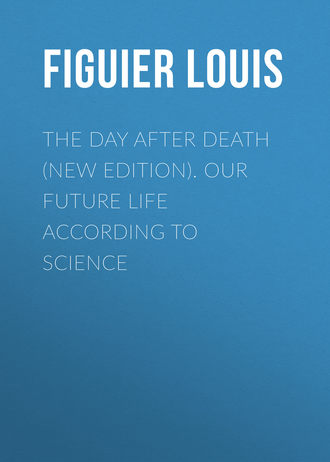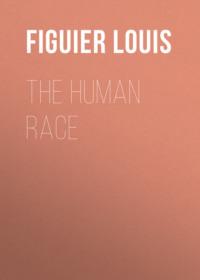 полная версия
полная версияThe Day After Death (New Edition). Our Future Life According to Science
Theophilus. We are indeed.
The Author. When we know that those terrible distances, which appal the imagination, are only the results of observations made by our telescopes, and capable of any amount of extension; when we reflect that the innumerable worlds thus revealed to us continue farther and farther, that ever new agglomerations of suns, planetary earths and their satellites add themselves to those which we can measure, without limit and without end, that the imagination cannot err in following them to the uttermost limits of its powers; then, my dear Theophilus, we comprehend that the universe is truly infinite. And if you consider that these endless ranks of solar systems have all their following of planets and satellites, filled with living beings, plants, animals, men, and superhuman creatures, that flaming comets traverse the orbit of each world at intervals and plunge into the burning furnace of its sun; that these milliards of suns are endlessly various, and that all the complicated motions of these different systems are accomplished with perfect order, without any mutual disturbance, you will find that the universe is not only the infinite in extent, but, also in order, harmony, equilibrium of motion, and laws!
Theophilus. The mind loses itself in such thoughts; for the idea of the infinite is not made for our feeble intelligence. Let us go no farther, or our reason will fail us.
The Author. Nevertheless, I must pursue my long argument to the end. I must add that in the midst of this boundless space, above this immense cortége of stars, which are the dwelling places of living creatures and sentient souls, there exists the Supreme Author, the Sovereign Ordainer, from Whom, as their sacred source, all that our eyes behold, our souls feel, and our intelligence admires, is derived. He, whom I bless with all the gratitude of my heart—God!
Theophilus. Thus, then, you have reached the true object of your discourse. This journey through space is undertaken to prove that God, being infinite in moral perfections, may be placed in that infinitude in extent, called the universe. It only remains now to say in what precise spot you place the sojourn of the Divinity, for I do not see how there can be a centre to the Infinite, seeing it has neither beginning nor end.
The Author. I am about to explain myself on this point. The absolute fixity of the sun and the stars was an astronomical principle, which, in the time of Newton, appeared to be indubitable. But science never stands still. Observations made in the present century have proved that the fixity, the immobility of the sun is only relative. The truth is that the sun, and with him the entire system of planets, asteroïds, satellites, and comets, which he carries, in his train, change their places, very slightly no doubt, but still appreciably. Our sun appears to advance slowly, with all the planetary family, towards that part of the sky in which the constellation of Hercules is situated, at the rate of 62,000,000 of leagues each year, or two leagues each second, describing an orbit which comprehends millions of centuries. That which is the case with our sun is equally the case with the other suns, that is to say, the stars. This general motion of translation must be common to all the stellar systems, and it is indubitable that the countless millions of solar systems suspended in infinite space, are moving more or less quickly towards an unknown point in the sky. Now, there is nothing to forbid the supposition that all these circles or ellipses traced by myriads of solar systems, have a common centre of attraction, towards which our system and all the others gravitate. Thus, all these celestial bodies, without exception, all this ant-hill of worlds which we have enumerated, may be turning round one point, one centre of attraction. What forbids us to believe that God dwells at this centre of attraction for all the worlds which fill infinite space?
Theophilus. Now I understand your thought, and I am struck by its grandeur. This God, placed at the mathematical centre of the worlds which compose the universe, this infinite intelligence, throned in the centre of the infinite universe, and presiding over the movements of all the innumerable phalanxes of heavenly bodies which our imagination can conceive, responds to the idea which we form of God, if we venture to face the awful personality of His Omnipotence. You have done well to develop this theory in your work. It will be in harmony with the kind of religious spirit which animates it, and which is, besides, the expression of the desires, and the aspirations of the men of our time.
In the present day a deep and profound need of belief in Providence makes itself felt. Men want to render homage to God, in whom they feel there is truth, peace, and safety for the present and in the future. But the established religions leave many minds in cruel uncertainty. In "The Day after Death" you have endeavoured to lay the foundations of the religion of science and of nature. These principles respond, as I believe, to the prevalent wishes of mankind. They satisfy the mind and the heart, sentiment and reason; they console and strengthen; in short, they consecrate the idea of God, without laying aside either the universe or nature.
The Author. So be it!
THE END1
Ch. XV.
2
Rambosson. "The Laws of Life." Paris, 1871. P. 121.
3
"We must consider," says Bremser, "that man is not a spirit, but only a spirit limited, in different ways, by matter. In a word, man is not a god, but, notwithstanding the captivity of his spirit in his corporality, it retains sufficient freedom to enable him to perceive that he is governed by a spirit more exalted than his own, that is to say, by a God.
"It is to be presumed, in the supposition that there will be a new creation, that beings far more perfect than those produced by preceding creations will see the light. In the composition of man, spirit holds to matter the proportion of fifty to fifty, with slight occasional differences, because it is now matter, and again spirit which predominates. In a subsequent creation, should that which has formed man not prove to be the last, there will apparently be organizations in which spirit will act more freely, and be in the proportion of seventy-five to twenty-five.
"It results from this consideration that man, as such, was formed at the most passive epoch of the existence of our earth. Man is a wretched intermediary between animal and angel, he aspires to elevated knowledge, and he cannot attain to it; though our modern philosophers sometimes think so, it is really impossible. Man wishes to make out the primary cause of all that exists, but he cannot get at it. With less intellectual faculty, he would not have had the presumption even to desire to know these causes; and, if he were more richly endowed, they would have been clear to him."—L'Univers, pp. 760-761.
4
On this subject see the book of Dupont de Nemours, "Philosophie de l'Univers," quoted by M. Pezzani in his "Pluralité des existences de l'âme," pp. 216-218.
5
Represented by the French word hectare.
6
Quoted by Flammarion in his "Pluralité des mondes habités."
7
See "Le Soleil," by M. A. Guillemin, pp. 194-208.
8
"Palingénésie Philosophique," vol. ii. pp. 427 and following.
9
"Revue des Deux Mondes," 15th April, 1868.
10
"Liber de animâ," ch. xlvi
11
Pezzani: "Pluralité des Existences de l'âme," pp. 206-210.
12
This question is specially considered in Descartes' "Discours sur la Méthode."
13
"De l'Instinct et de l'Intelligence des Animaux," Paris, 1861.
14
"Etudes Philosophiques sur l'Instinct et l'Intelligence des Animaux," Strasbourg, 1853.
15
"Histoire des Plantes," Paris, p. 111.
16
"Contemplation de la Nature (Œuvres d'Histoire Naturelle de Charles Bonnet.") Neuchâtel, 1781.
17
Milton, in his Paradise Lost, says that before the fall of our first parents, perpetual spring reigned upon the Earth, but that as soon as Adam and Eve had eaten the forbidden fruit, angels, with flaming swords, were sent from Heaven to incline the poles of the Earth more than 20 degrees. It is well for us that the angels did not cause them to incline farther, or our seasons would have been still shorter and more defective. Fourier pretends that it would be possible for humanity to produce an effect sufficiently great to set the globe straight upon its axis, and thus restore the equality of the seasons, and perpetual spring. This philosopher forgot to indicate one thing only, the mechanical means by which man is to produce this effect. This theory reminds us of the drowning man who fancied he could save himself by catching hold of his own hair, while he was struggling in the water.
18
"La Pluralité des existences de l'âme," Paris, p. 450.
19
"La Religion des Hindous selon les Védas," par Lanjuinais, Paris, p. 286.
20
"La Religion des Hindous selon les Védas," pp. 324, 325.
21
"Histoires," Vol. II. ch. cxxiii. (translated by M. Larcher.)
22
Quoted by M. Pezzani, in his "Pluralité des Existences de l'âme," pp. 261-263.
23
Arago. "Astronomie Populaire," Vol. I., pp. 372-376.
24
Arago. "Astronomie Populaire," Vol. I., pp. 376-380.
25
Flammarion. "Pluralité des Mondes habités," page 195.
26
See the Author's work: "The Earth before the Deluge," pp. 402-440.
27
Flammarion. "Pluralité des Mondes Habités," page 203.
28
Flammarion. "Pluralité des Mondes Habités," page 203.




